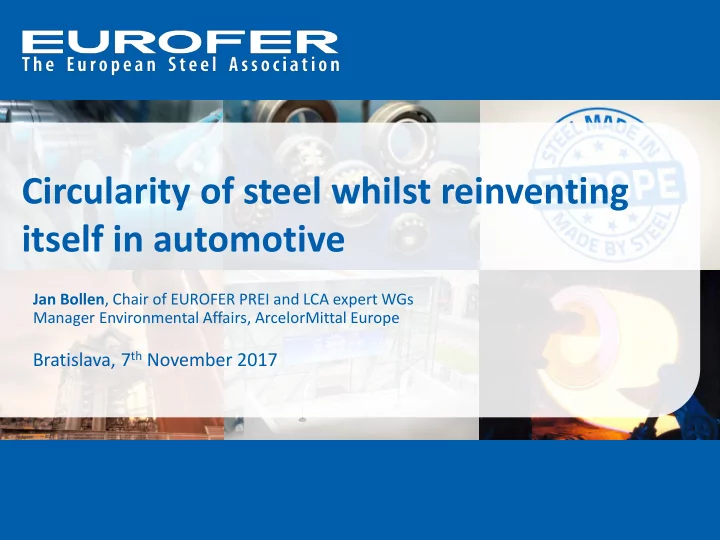

Circularity of steel whilst reinventing itself in automotive Jan Bollen , Chair of EUROFER PREI and LCA expert WGs Manager Environmental Affairs, ArcelorMittal Europe Bratislava, 7 th November 2017
EUROFER, THE EUROPEAN STEEL ASSOCIATION • EUROFER ( ° 1976) • It represents 100 per cent of steel production in the European Union • EUROFER members are steel companies and national steel federations throughout the EU • The European steel industry has a turnover of about 170 billion euros and direct employment of about 330 thousand highly skilled people, producing on average 170 million tonnes of steel per year • More than 500 steel production sites in 24 EU Member States provide direct and indirect employment and a living for millions of European citizens. • Closely integrated with the European manufacturing industries, steel producers provide the basic material for innovation, growth and wealth in Europe. Thousands of different types of steel facilitate and improve our daily life • Steel is 100 per cent recyclable and therefore contributes significantly to the conservation of fundamental resources. As a basic engineering material, steel is also essential in innovative technologies for more resource efficiency and sustainable development in Europe.
MAIN CHALLENGES FOR THE AUTOMOTIVE INDUSTRY TODAY Global CO 2 (or equivalent) regulation trends › SUSTAINABILITY › Fuel economy and emission reduction regulations › Electrification › Autonomous Source: The Economist driving › Car sharing › ENHANCED SAFETY PERFORMANCE › AFFORDABILITY › GLOBAL PLATFORMS › GEOGRAPHICAL PRODUCTION SHIFTS Source: icct 3
“REINVENTING STEEL” IN AUTOMOTIVE • Advanced steel solutions replacing “traditional” steels: – reducing weight and improving crash resistance; – combining strength with ductility: hot stamping, tailor welded blanks, … A D . C Example of application of press hardened steels: Volvo XC 90 B 125 kg lighter than its predecessor and 200 kg lighter than most of its competitors . XC90's body & components structure Press hardened steels 40% 60% Other 40% of the Volvo XC90 uses press hardened steel – the most in any vehicle
“TRUE RECYCLING”, WITH STEEL A “PERMANENT MATERIAL” • End-of-life vehicle: – dismantling & parts salvaging → parts for reuse or remanufacturing – depollution & shredding → material for recycling • Magnetic properties of steel: superior collection and pre-sorting in clean fraction. • Final recycling process: chemical cleaning of scrap and new steel products with “intact” properties (no downcycling !) • A “permanent material” (BSI) standard 8905:2011, the above recycling loop can be continuously perpetuated; • In EU, more >50% of all steel produced is made from ferrous scrap.
LIFE-CYCLE PERSPECTIVE IN ENVIRONMENTAL ASSESSMENT AND REGULATION Towards addressing embedded emissions: Information sharing platform Voluntary LCA reporting EU-wide product category rules Life cycle based credit options Source: Volkswagen
CONCLUSIONS 1. Steel “reinvented” in automotive: advanced solutions enable major weight saving while improving crash resistance; 2. Superior recycling performance : “true” recycling, as steel is “a permanent material”; 3. Life-cycle perspective supporting environmental assessment and regulation.
Recommend
More recommend